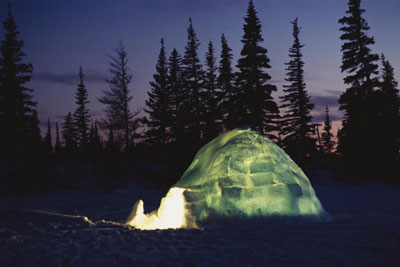
1 As warm as toast!
- Igloos keep you toasty and warm even in the worst winter conditions. But how do they do that when snow itself is naturally really cold?
- How does it work when, in places like Lapland, temperatures can easily drop many tens of degrees below freezing with a wind chill factor to match?
- You might think that igloos can't work.
- Why don't they melt as you sit inside, freezing you like a human icicle?
- Why doesn't the snow itself cool down the air inside the igloo so much that it just gets colder and colder?
- What about the wind?
- And how do you sleep on a bed of actual ice? It's fascinating.
2 How does an igloo work? It's an insulation thing
- Igloos are built from compressed snow. You saw it into chunks like building blocks, then stack the blocks around a circular layered hole in the snowy ground.
- Snow is endlessly interesting considering it's simply semi-frozen water. It has amazing insulating properties that make it a popular shelter-building material for hibernating animals as well as humans, creatures like bears and raccoons.
- Solid ice isn't a very good insulator compared to compressed snow, simply because ice is solid while snow is filled with miniature air pockets. While it looks solid, as much as 95% of snow is actually air trapped inside tiny crystals. Because the air can't circulate very well inside the ice crystals, the heat gets trapped in there.
- So how does an igloo keep you warm? An igloo floor is never just flat like the inside of a tent. It's cut into layers which create an upper level for sleeping, a middle level for the fire and a lower level used as a cold sink. Heavy cold air, which naturally falls, collects on the floor – ideally near the door - and stays there. And warm air, which is lighter and naturally rises, stays in the parts of the igloo people use the most, including the area they sleep in.
- And, sometimes used, a little hole cut into the top of the curved roof lets smoke from the fire escape safely.
- All this means it can be as cold as minus fifty degrees Fahrenheit outdoors but as cosy as 19 to 61 degrees Fahrenheit indoors, not always warm enough for a T shirt but a temperature difference that'll feel really good all the same, sometimes as much as seventy degrees warmer than the outdoors.